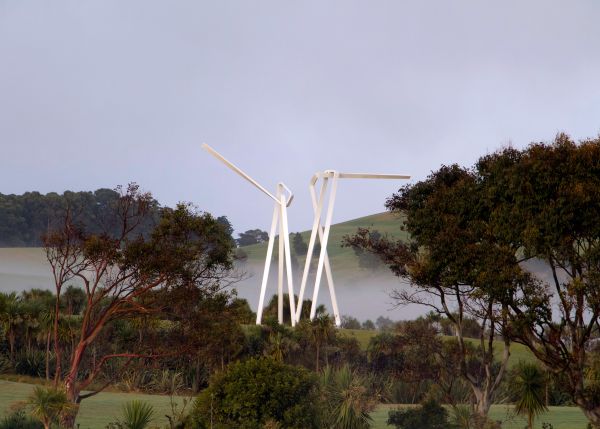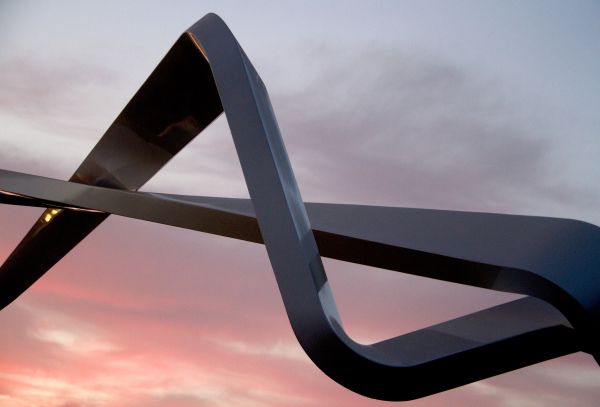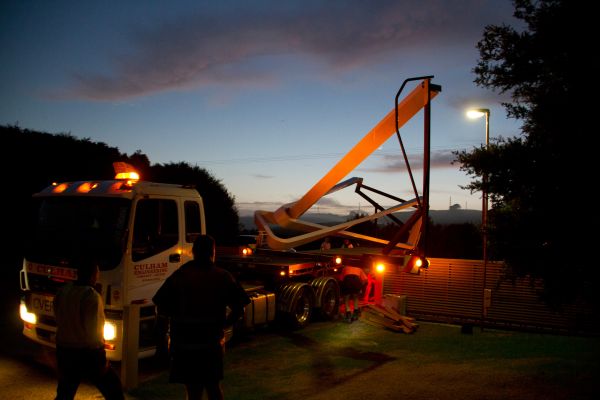Tango Dancers
2014. Auckland, New-Zealand
In 2009, Alan Gibbs invited me to make a design for a second work of art for the 400 ha Gibbs Farm, where I had realized The Mermaid (1999) before.
I was surprised but certainly also felt honoured that I was asked to do this on The Gibbs Farm. This favour he had not granted to a single artist from the internationally acclaimed group represented there. The Mermaid (bridge) had already been there for ten years. As it is quite cumbersome to design a sculpture remotely, I was happy to show Alan Gibbs a first design of the two Tango Dancers during a visit in London. My sketches also indicated the level of difficulty of the bent forms in the upper parts of the sculptures. What makes it so pleasant to work with Alan is that besides being the client, he is a good engineer at the same time. Thus, he unerringly senses certain things like technical complications and simultaneously instils the confidence that technical challenges will be taken care of adequately by his engineer Peter Boardman. Alan, who identifies strongly with art, together with Boardman and Noel Lane (director of the Gibbs Farm and architect) makes sure that all sculptures are actually realized.
By what was I inspired anew?
Firstly, by the amazing estate with its breathtaking nature, but foremost by the light, which keeps changing. Furthermore, the horizon without skyscrapers turns the clouds into still-life, moving works of art: a kind of video. Having considered all these elements I thought of something vertical, shimmering from far away, as a kind of marking.
The tango is a 2/4 or a 4/4 rhythm with syncopation (temporary reversal of heavy and light stresses) and comes originally from Argentina. The most tender and sensual aspect of this dance lies for me in the partners touching each other’s forearm. My Tango Dancers though are shy and touch each other only with their foot. Sculptures made of steel strip, either thin or thick, owe their multiply visual character to the changing effect of the strip; sleek, graphic, wide and robust. In this way you can achieve maximal effects by using minimal means and colour. It is just the contrasts between the two parts of the Tango Dancers and the material expression which makes the sculpture so interesting. In addition, you note the slender whitish dancers already from far away, with at their feet the gigantic weathering steel sculpture Te Tuhirangi Contour (252 x 6 x 0.05m) by Richard Serra.
In February 2012, I received the invitation to again visit the Gibbs Farm in New Zealand, where I was received most warmly by Alan Gibbs, Noel Lane and Peter Boardman. We had a number of very professional discussions about the task lying ahead of us, i.e. to realize a strongly bent steel sculpture which – at first sight – looked rather impossible. We talked about the degree of difficulty of this sculpture, who could engineer this work, who could manufacture it and which would be the adequate place for it. Boardman is a very experienced and liberal engineer. I often sought his advice. Throughout the process he never lost his temper. We frequently went to the manufacturing plant where the sculptures were made with great care, from twisted elements in steel moulds, and where the preparations for the transport took place. Till the very last moment I disagreed with Boardman on the aspect of the solution which was found for the ‘knot’ of the vertex high in the two sculptures. Finally, I had to admit that an additional internal connection between these two separate bends would definitely be essential – this in connection with the hard winds in Kaipara Harbour which quite regularly can reach speeds of up to 160km/h.
Gibbs: “Marijke did not make it easy for me. Her sketches were fabulous, but – and this as well is a typical female feature – she had not looked closely enough whether her design could be put into practice. It is namely impossible to bend massive steel in such a way. We had to find a solution for this.” The Tango Dancers are for the largest part bent or twisted and have a number of sharp angles. In the production process a steel pipe is used as basic mould on which small steel plates are fixed in a perpendicular way. By welding, the constructional plate surfaces are subsequently brought by the small steel plates. Gibbs: “By doing so, we could bend and twist the beams in these strange curves”. There are really thousands of connections and welds – but the end result is a smooth and continuous surface of bent steel.
At three o’clock in the morning the two sculptures were transported from the manufacturing plant to the Gibbs Farm by two trucks with big trailers. At six o’clock the two Tango Dancers arrived without any damage. Cranes lifted the sculptures with great care and placed them on each one of the three foundation points. It is an unbelievable achievement that these sculptures (‘man’ and ‘woman’), each weighing about 8,500kg and 15m high, have only a distance of one centimetre from each other. In the end, the placement became a feast for all participants, from client, engineers and manufacturers to the artist.
The pearlescent colour of the Tango Dancers was devised on the basis of the fabulously shimmering mother of pearl-shells which can be found in Kaipara Harbour. Especially for this project, the paint coating was developed in the Netherlands. It consists of at least four layers, of which the top coating contains small aluminium particles which make the work of art shimmer in the sunlight. Therefore the sculpture appears bluish in the morning, yellowish in the afternoon sun and in the evening a pinkish or reddish hue prevails.
The work of art forms a spectacular contrast to the majestic work of Richard Serra with its length of 252 meters. My hope is that the visual disorientation of the Tango Dancers will be a source of joy and surprise at the Gibbs Farm.






